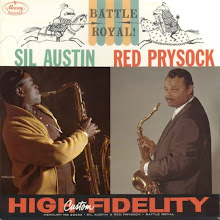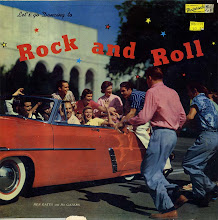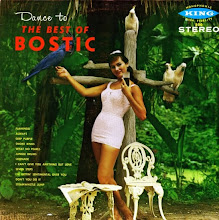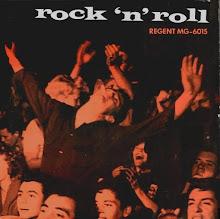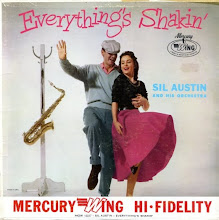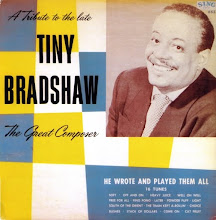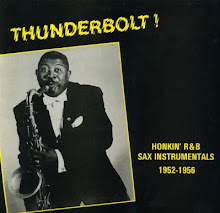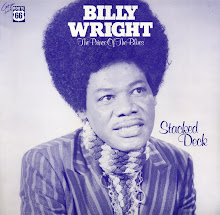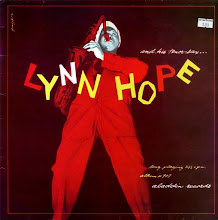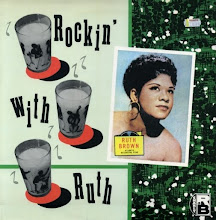Side 1
1. Hypin' Woman Blues
2. Too Much Trouble Blues
3. I Got A Break Baby
4. Mean Old World
5. Bobby Sox Blues
6. I Know Your Wig Is Gone
7. T-Bone Jumps Again
8. Call It Stormy Monday
Side 2
1. You're My Best Poker Hand
2. First Love Blues
3. She's My Old Time Used To Be
4. On Your Way Blues
5. I Wish You Were Mine
6. Wise Man Blues
7. Born To Be No Good
8. T-Bone Shuffle
This is a glorious Charly collection of pioneer of the electric blues guitar T-Bone Walker’s classic 1946-47 sides which he recorded for LA indy label Black and White, plus two sides he recorded for Capitol in 1942 while with the Freddie Slack Orchestra. I bought it way back in 1981 at a time when my jump blues collection consisted of little more than a handful of Swing House LPs, a best of Louis Jordan compilation on MCA, a scratched second hand Amos Milburn comp on United Artists and some imported King releases on Gusto. So you can imagine the impact these jumpers, jivers, shuffles and blues had on the as yet youthful Be Bop Wino.
Oh sure, I could write at length about the importance of T-Bone Walker in the history of R&B. About how every blues guitarist and (shudder) blues-rawk axeman owes him a debt of gratitude. Or perhaps I would be better looking back to the influences and experiences that shaped T-Bone’s music and stage act, influences that reach back through string bands, Blind Lemon Jefferson, medicine shows, classic blues divas, chumming around with Charlie Christian, big bands, jamming all night with Lester Young, and just corny old showbiz in the shape of musical reviews and song and dance acts. But what this post is really about is the fantastic music contained in these sixteen tracks. They may be slightly crackly and scratched but I’ve had the LP for around thirty years, so what do you expect?
Quite simply this is probably the coolest music you’ll ever hear. It’s real relaxed West Coast Rhythm ‘n’ Blues with small jump bands led by Jack McVea and Bumps Myers providing subtle accompaniment to T-Bones’ smoky vocals and tasteful guitar licks.
Texan T-Bone arrived in California sometime in the mid 1930s. Big Jim Wynn remembered him in the Little Harlem Club in Watts in 1936: “He was dancing and picking up tables with his mouth. He’d dance on a table and then grip it in his teeth and whirl it around. That’s what Miss Brown booked him for, as a dancer. He started singing with the first small band I had and the people went mad about him. He had a funny little box he’d play, a contraption he had made himself …” Sounds like T-Bone was already experimenting with an amplified guitar.
In 1939 T-Bone joined the big band of Les Hite as a vocalist. In fact this was a new edition of the long established band as in September 1939 Hite had dismissed his own band and taken over that of Floyd Turnham. The band went on an extensive tour, opening in Dallas at the end of September (they may have picked up T-Bone in his old home town), and in January 1940 arrived in New York. “Downbeat” noted that “his new star is T-Bone Walker with choruses on ‘I wonder why she don’t write to me.’” While in New York, the band recorded for Varsity with T-Bone’s vocals (but not guitar) being showcased on “T-Bone Blues.”
During the tour T-Bone experimented backstage with a Gibson electric guitar and on his return to LA he developed a sensational crowd pulling act with his new instrument. He had the tricks which in later years would be used by Chuck Berry and Jimi Hendrix – playing the guitar behind his head and while doing the splits. Club success brought him to the attention of new label Capitol Records. In July 1942 T-Bone was on several Capitol sessions with the Freddie Slack Orchestra, a boogie based big band which had the fabulous Ella Mae Morse on vocals (along with Johnny Mercer).
At the end of his first session with the full band (having recorded “Mister Five By Five” and several other tracks), T-Bone was backed by a rhythm trio from the band (including Freddie himself) on “Mean Old World” and “I Got A Break Baby.” This was the first time that T-Bones’ by now fully developed vocal / guitar style was recorded. However, the first Petrillo recording ban brought a temporary hiatus to his recording career. It would be over two years before T-Bones’ electric blues guitar would be captured on wax again, this time for the Chicago based Rhumboogie label, which was a promotional tie-in for the successful Chi-Town Rhumboogie night club.
The Rhumboogie opened in April 1942 with a show headlined by the Tiny Bradshaw band. In August 1942 T-Bone opened at the club as the headliner in “The Dream Revue,” a show which featured singers, dancers, chorus girls and the Milt Larkin band with Arnett Cobb and Tom Archia on saxes. The Revue, which ran until October, was a massive success and in January 1943 T-Bone was back at the club, once again with the Milt Larkin band providing backing. T-Bones’ 1944 run at the club was another success, being repeatedly extended until Wynonie Harris took over as the headliner.
As T-Bones’ 1944 spell at the Rhumboogie drew to an end at the beginning of October, he recorded six tracks for the new Rhumboogie record label backed by the Marl Young band who were by now the house band at the club. “Sail On Boogie” in particular was a storming showcase for T-Bones’ electric guitar. Three singles were released from this session, and a further session of four songs was recorded in December 1945, but none of these later recordings was released on Rhumboogie. However, two of the tracks were released as a single on Mercury.
In September 1946 T-Bone signed up with the Los Angeles based Black and White label for whom he recorded under the supervision of Ralph Bass until the end of 1947. At the two 1946 sessions T-Bone was backed by label mate Jack McVea’s band, with trumpeter Al Killian being added on the second session in December 1946. For the 1947 sessions, studio bands centred on tenor sax man Bumps Meyers and former Les Hite drummer Oscar Lee Bradley provided sterling support. Other musicians involved included pianists Lloyd Glenn and Willard McDaniel, trumpet players Teddy Buckner and George Orendorff and bass player Billy Hadnott.
The Black and White recordings had considerable commercial success with “Bobby Sox Baby,” “Stormy Monday,” “Long Skirt Baby Blues,” “I Want A Little Girl,” “I’m Waiting For Your Call,” “Midnight Blues,” “West Side Baby,” “Description Blues” and “T-Bone Shuffle” all entering the R&B charts between 1947 and 1949.
Despite achieving good sales for records by Jack McVea and T-Bone, Black and White ran into financial problems during 1948, eventually going out of business. The T-Bone masters were bought up by Capitol in April 1949. Their new owners remastered and renumbered the tracks and reissued many of them, leading to considerable discographical confusion, which is reflected in the sleevenotes to this LP. When T-Bone resumed his recording career in 1950, he had signed with Lew Chudd’s Imperial label. That story, however, is for another post and another day.
Ripped from vinyl at 320 kbps.
Download from here:
http://www104.zippyshare.com/v/pFGTa3PK/file.html
1. Hypin' Woman Blues
2. Too Much Trouble Blues
3. I Got A Break Baby
4. Mean Old World
5. Bobby Sox Blues
6. I Know Your Wig Is Gone
7. T-Bone Jumps Again
8. Call It Stormy Monday
9. You're My Best Poker Hand
10. First Love Blues
11. She's My Old Time Used To Be
12. On Your Way Blues
13. I Wish You Were Mine
14. Wise Man Blues
15. Born To Be No Good
16. T-Bone Shuffle
“I Got A Break Baby” and “Mean Old World” were recorded in Hollywood on July 20th, 1942, with Freddie Slack and His Orchestra, rhythm section only. Freddie Slack (p); Jud De Naut (b); Dave Coleman (d)
“Bobby Sox Blues” aka “Bobby Sox Baby” was recorded in Hollywood on September 30th, 1946 with the Jack McVea All Stars. Joe “Red” Kelly (tp); Jack McVea (ts); Tommy “Crow” Khan (p); Frank Clarke (b); Rabon Tarrant (d)
“I Know Your Wig Is Gone,” “T-Bone Jumps Again” and “Call It Stormy Monday” were recorded in Hollywood on September 13th, 1947. Teddy Buckner (tp); Bumps Myers (ts); Lloyd Glenn (p); Arthur Edwards (b); Oscar Lee Bradley (d)
“She’s My Old Time Used To Be” and “Too Much Trouble Blues” were recorded in Los Angeles on November 6th, 1947. “Hypin’ Woman Blues” and “On Your Way Blues” were recorded in Los Angeles on November 7th, 1947. Teddy Buckner (tp); Bumps Myers (ts); Willard McDaniel (p); Billy Hadnott (b); Oscar Lee Bradley (d)
“First Love Blues” was recorded in Los Angeles on November 12th, 1947. George Orendorff (tp); Bumps Myers (ts); Willard McDaniel (p); Billy Hadnott (b); Oscar Lee Bradley (d)
“T-Bone Shuffle” was recorded in Los Angeles on November 13th, 1947. George Orendorff (tp); Bumps Myers (ts); Willard McDaniel (p); John W. Davis (b); Oscar Lee Bradley (d)
“Wise Man Blues” and “I Wish You Were Mine” were recorded in Los Angeles on December 17th, 1947. “Born To Be No Good” was recorded in Los Angeles on December 18th, 1947. Jack Trainor (tp); Bumps Myers (ts); Willard McDaniel (p); Billy Hadnott (b); Oscar Lee Bradley (d)
“You’re My Best Poker Hand” was recorded in Los Angeles on December 29th, 1947. George Orendorff or Jack Trainor (tp); Bumps Myers (ts); Willard McDaniel (p); Billy Hadnott (b); Oscar Lee Bradley (d)
Sources:
Mark Humphrey – liner notes to the Capitol Blues Collection 3CD set “T-Bone Walker: The Complete Capitol / Black & White Recordings”
Helen Oakley Dance – “Stormy Monday: The T-Bone Walker Story”
Robert Pruter and Robert L Campbell - "The Rhumboogie: the rise of a great black and tan" in Blues and Rhythm, number 190, June 2004
Bill Millar – “Let The Good Times Rock!”
Albert McCarthy – Big Band Jazz
The Bruyninckx Discography
Arnold Shaw: Honkers And Shouters
Big Al Pavlow’s R&B Book
Cliff White: sleevenotes to Charly LPs “The Natural Blues” and “Plain Ole Blues.”
Mo’ T-Bone:
“The Complete Capitol / Black & White Sessions” – a 3CD set issued in the Capitol Blues Collection series in 1995. It includes the 48 recordings made for Black & White in 1946 and 1947, the 2 recordings with Freddie Slack for Capitol from 1942, and “T-Bone Blues” made with the Les Hite band for Varsity in 1940. There are 75 tracks in total on this set with the balance being made up of alternate takes of many of the Black & White tracks. Immaculate packaging and sound quality. Indispensable but almost impossible to find.
You might have a better chance of finding the Proper 4 CD set “The Original Source” which has 90 tracks recorded between 1930 and 1951.





























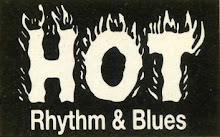
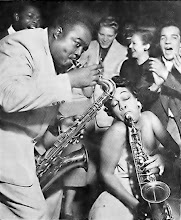






%2045%20-%201003A.png)
.jpg)
















